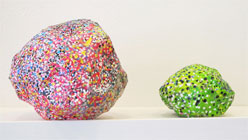Creative Growth has arrived in New York City — more specifically, to the Lower East Side’s Rachel Uffner Gallery. It’s the epicenter of contemporary art cool, and this group show of ten CG artists fits into the neighborhood seamlessly. In fact, it’s better than any of the work I’ve seen recently in the nearby Orchard Street galleries.
Founded in 1974, Creative Growth Art Center is a fixture of the Bay Area. Based in Oakland (its counterpart, Creativity Explored, is in the Mission district of San Francisco), the art studio and gallery supports mentally, physically and developmentally disabled adult artists. And what incredible artists they are. Creative Growth may provide vital service to disabled adults who have otherwise been largely ignored and disenfranchised by society, but it also fosters the practices of complex artists. For that, we are all lucky.

John Hiltunen, Untitled, 2012
This show, curated by White Columns director Amie Scally and titled Creative Growth, features the work of David Albertsen, Maureen Clay, John Hiltunen, Dwight Mackintosh, Dan Miller, Donald Mitchell, Aurie Ramirez, Judith Scott, William Scott, and William Tyler. Each artist is wildly different in intent and affect. John Hiltunen’s series of eight collages feature oversized animal heads on female models crudely cut up and placed in front of natural landscapes; they are equal parts unexpectedly funny and disconcerting. Maureen Clay’s small, papier-mâchéd forms mimic rocks, though in this case, psychedelic ones: each form is painted in abstract, pointillist detail with bright acrylics. In fact, they remind me of less contrived versions of works in the Yayoi Kusama show uptown at the Whitney Museum. Judith Scott, the other sculptor in the show, tightly wraps bundles of fabric and string into misshapen, sinuous spheres. They recall abnormal bodily growths — think of the bound clothing sculptures of Shinique Smith, but more modest and less calculated. Donald Mitchell’s ink on paper drawings feature quasi-identical, darkly dressed figures floating in a gravity-free crowd, some with indecipherable thought bubbles. In the larger of his two pieces, the figures are densely packed onto the page, but rarely touch one another. David Albertson’s pastels are the most vividly colored in the show, and depict semi-mystical scenes with subjects related to — or situated underneath — watery landscapes.

Dan Miller, Untitled, 2011
Dan Miller’s ink on paper abstract drawings are particularly gripping. They appear to have been made with a black, ball point pen scratched over and over on the paper’s white surface, creating a dense, but not fully opaque form that is darker in the middle and becomes feathered towards its edges. The pieces appear to me as dimensional clouds, aerial surfaces, and pile ups of discarded hair on the surface of a barbershop. They also appear to be nothing but themselves: lines drawn furiously (and carefully, if both of those qualities can exist at once) over and over, until the pen or the author expires. Miller also makes text pieces that are far less dense, but also employ the pen on paper “pile up” effect. Writing backwards and forwards and doubling rounded text over itself, those pieces feel less like an earthquake and more like a tremor, as if Miller made them while riding inside of a turbulent machine.



